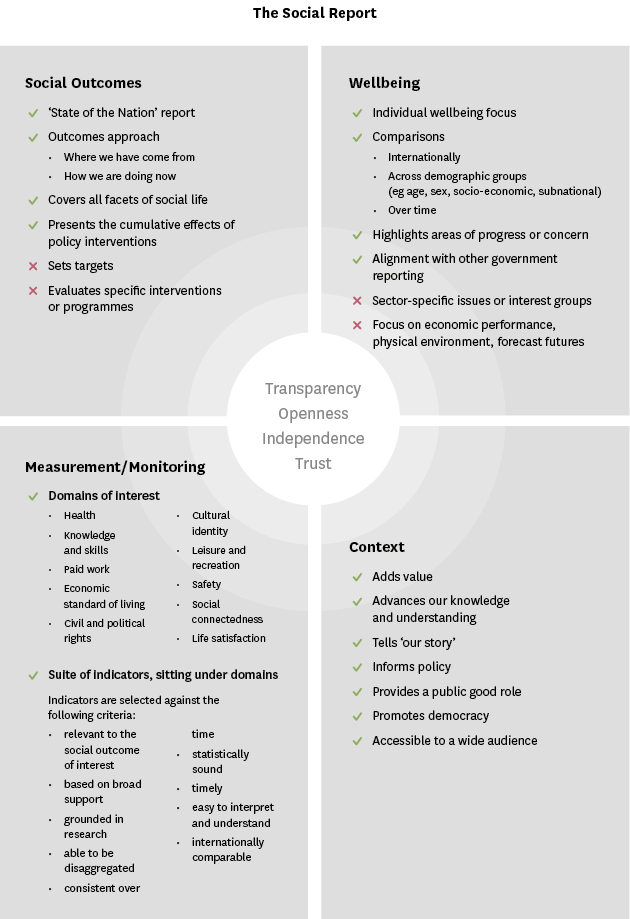Appendix 1: The Social Report framework
The Social Report can best be described as a state of the nation report. It uses statistical indicators to monitor trends across key dimensions of people’s lives to provide a picture of progress towards better social outcomes for New Zealanders.
The Social Report:
- reports on social indicators that complement existing economic and environmental indicators
- compares New Zealand with other countries on measures of wellbeing
- contributes to better-informed public debate and advances knowledge and understanding of social issues
- aids planning and decision-making and helps identify key areas for action.
A consultation round with key stakeholders in mid-2014 confirmed that the role and purpose of the Social Report remain strongly supported. This highlights the continued high reputation of the report and the unique position it holds in reporting on social wellbeing.
By concentrating on broader measures of wellbeing and taking an outcomes approach, the Social Report helps to understand the cumulative effect of policy interventions, rather than the impact of single intervention programmes or sector-specific issues. Pragmatically, the report focuses on individual wellbeing and concentrates on how we are doing as a nation overall.
The Social Report provides an important platform for getting information about wellbeing into the wider public domain, ensuring not only that social trends are monitored and visible, but that emerging areas of social concern are highlighted. It is the only comprehensive social wellbeing report in New Zealand.
The report is built around wellbeing domains covering all facets of social life and reports progress under these domains using national and sub-national indicators. The domains have been selected to reflect areas that contribute to social wellbeing. While the domains are regularly reviewed, they currently are:
- Health
- Knowledge and skills
- Paid work
- Economic standard of living
- Civil and political rights
- Cultural identity
- Leisure and recreation
- Safety
- Social connectedness
- Life satisfaction
The framework guides the selection of indicators that sit within these domains. Our well-established and robust selection criteria help us to derive a balanced and manageable set of indicators from the mass of statistics available.
Indicators for the Social Report are selected against the following criteria:
- relevant to the social outcome of interest – the indicator should be the most accurate statistic for measuring both the level and extent of change in the social outcome of interest, and it should adequately reflect what it is intended to measure (ie it should be valid)
- based on broad support – there should be wide support for the indicators chosen so they report on a broadly shared understanding of wellbeing
- grounded in research – there should be sound evidence on key influences and factors affecting outcomes
- able to be disaggregated – ideally, it should be possible to break the data down by age, sex, socio-economic status, ethnicity, family or household type, and region, so we can compare outcomes for different population groups
- consistent over time – the indicator should be able to be defined and measured consistently over time to enable the accurate monitoring of trends
- statistically sound – the indicator uses high-quality data and the method used to construct it is statistically robust
- timely – data should be collected and reported regularly to ensure indicators are providing up-to-date information
- easy to interpret and understand – indicators should be simple to interpret and what the indicator is measuring should be obvious to users
- internationally comparable – as well as reflecting the social goals of New Zealanders, indicators should be consistent with those used in international monitoring programmes so we can make comparisons.
Trade-offs between these criteria are sometimes required. For example, it may be necessary to choose an indicator where data is produced at long intervals to ensure a consistent time series is available.
In some outcome domains there is an abundance of good data from which to draw appropriate indicators, while in other outcome domains there is less good-quality or relevant data available. The number of indicators under each domain may therefore be uneven.
Data for the indicators for the Social Report is sourced from across the social sector and more widely. The report provides comparisons across demographic groups, where available and appropriate (eg age, sex, ethnicity, socio-economic, subnational), internationally and over time. By concentrating on wellbeing it cannot cover all activities but it has been developed to align with and support other government reporting.


